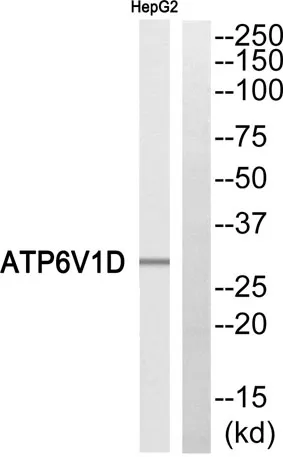V-ATPase D rabbit pAb
CAT:
855-ES6522-02
Size:
100 μL
Price:
Ask
- Availability: 24/48H Stock Items & 2 to 6 Weeks non Stock Items.
- Dry Ice Shipment: No




V-ATPase D rabbit pAb
- Description: This gene encodes a component of vacuolar ATPase (V-ATPase), a multisubunit enzyme that mediates acidification of eukaryotic intracellular organelles. V-ATPase dependent organelle acidification is necessary for such intracellular processes as protein sorting, zymogen activation, receptor-mediated endocytosis, and synaptic vesicle proton gradient generation. V-ATPase is composed of a cytosolic V1 domain and a transmembrane V0 domain. The V1 domain consists of three A and three B subunits, two G subunits plus the C, D, E, F, and H subunits. The V1 domain contains the ATP catalytic site. The V0 domain consists of five different subunits: a, c, c', c", and d. Additional isoforms of many of the V1 and V0 subunit proteins are encoded by multiple genes or alternatively spliced transcript variants. This gene encodes the V1 domain D subunit protein. [provided by RefSeq, Jul 2008],
- Synonyms: ATP6V1D; ATP6M; VATD; V-type proton ATPase subunit D; V-ATPase subunit D; V-ATPase 28 kDa accessory protein; Vacuolar proton pump subunit D
- Gene ID: 51382
- UniProt: Q9Y5K8
- Cellular Locus: Membrane ; Peripheral membrane protein ; Cytoplasmic side. Cytoplasmic vesicle, clathrin-coated vesicle membrane ; Peripheral membrane protein. Cytoplasm, cytoskeleton, microtubule organizing center, centrosome. Cell projection, cilium. Localizes to centrosome and the base of the cilium..
- Host: Rabbit
- Species Reactivity: Human, Mouse, Rat, Swine
- Immunogen: Synthesized peptide derived from V-ATPase D . at AA range: 70-150
- Clonality: Polyclonal
- Validated Applications: WB, ELISA
- Stability: 1 year
- Concentration: 1 mg/mL
- Dilution: Western Blot: 1/500 - 1/2000. ELISA: 1/40000. Not yet tested in other applications.
- Molecular Weight: 28kD
- Storage Conditions: PBS with 0.02% sodium azide and 50% glycerol pH 7.4. Store at -20°C. Avoid repeated freeze-thaw cycles.
